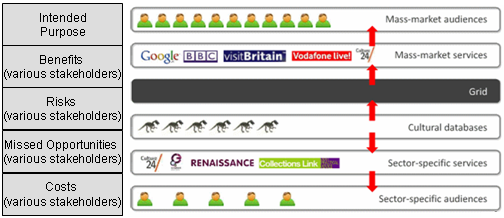A Risks and Opportunities Framework for the Culture Grid
Posted by Brian Kelly on July 22nd, 2009
Nick Poole, CEO of Collections Trust, was an invited speaker at the recent JISC Digital Collections conference. Nick’s talk, entitled Digital Britain or Digital Landfill: The Challenges to Heritage and HEIs, provided a vision for the online cultural environment and how the approaches being taken by Collections Trust, which are described in a blog post on the Culture Grid, relate to the interests of the higher and further education sectors.
Nick’s talk, which seemed to be warmly received, has been summarised by Tom Roper and Carrie Dunn on the JISC digitisation blog. In addition Nick has published his slides on Slideshare and they are embedded below.
I was particularly interested to see the slide (slide 22) in which Nick how cultural content, held in the ‘Cultural Grid’ can be accessed via a wide range of services, ranging from niche services for the the researcher and professional, sector-specific services through to the mass market services provided by well-known Web 2.0 companies.
The vision Nick described reflects one which I shared, in which there is a mixed economy, with resources being curated in a secure environment and a range of access services being used to maximise access to the content.
At the Museums and the Web 2009 conference I presented a paper on “Time To Stop Doing and Start Thinking: A Framework For Exploiting Web 2.0 Service” in which I described a framework for use by policy makers, managers and developers in addressing the risks of using Cloud Services. The paper explained how the framework needs to be applied to in-house development work and use of managed Cloud service (where they may be contractual agreements) as well as the various Web 2.0 services in which there may not be formal contractual agreements.
 The accompanying image illustrates how the framework, which has been described in more detail on this blog, can be applied to the development approach which Nick has described.
The accompanying image illustrates how the framework, which has been described in more detail on this blog, can be applied to the development approach which Nick has described.
One of the risks which has been identified in various Web 2.0 workshops which UKOLN has delivered to the cultural heritage sector has been the need for practitioners and policy makers in the cultural heritage sector to have a better understanding of the Social Web environment, in order to ensure that the opportunities it can provide are realised and the risks understood and strategies developed to minimise such risks.
The UKOLN work plan, which has been agreed in discussions with MLA, will continue to provide advice and best practices for the sector in order to build capacity in cultural heritage organisations. We will use this blog to keep the sector informed of our activities. We also welcome your comments and views.

July 24th, 2009 at 1:27 pm
Brian,
Many thanks for this very useful and thought-provoking view both on the presentation and on the overall development of the Culture Grid. I think that the framework you suggest is a very beneficial angle to take on these things – not only in this context but more broadly in the strategic targeting of investment in digital services.
I do feel a strong need to disentangle the various concepts underpinning the ‘Social Web Environment’ to which you refer. As a concept (and similarly to Web 2.0 itself) it conflates things which are principles with others which range from specific pieces of interface design (wiki, for example) to named brands (Wikipeida, Flickr, LinkedIn etc).
If there is a slightly disjointed nature to the response to these things from the Cultural Heritage setor, I think it is because we still need some time critically to assess which of these disparate elements it is that we mean (although I do also agree that there is a need to get to grips with some much broader principles such as collaborative asignation of authority and meaning to things).
At heart, I think there is a basic process going on of re-coding the Social Contract with the users of public services, including museums, archives and libraries. I think that initiative such as the Culture Grid and your work with UKOLN are the very early stages of a process which I hope will lead to a transformational change in the public perception of what these institutions are for, and how they can be engaged with in future.
I look forward to working with UKOLN on this more soon.
July 24th, 2009 at 2:29 pm
Hi Nick
Thanks for the response. I would agree that ‘Web 2.0′ and ‘Social Web’ are broad and ambiguous terms and in order to gain a better understanding of how they can be used in a cultural context we need to explore not only “specific pieces of interface design” and the potential of specific services but also their intended purposes. And the results of these discussions may well challenge the “Social Contracts” of public sector services. These issues have been highlighted in the higher education sector in the recent “Higher Education in a Web 2.0 World” and “The Edgeless University” reports.
I’m also looking forward to joint work in this area.